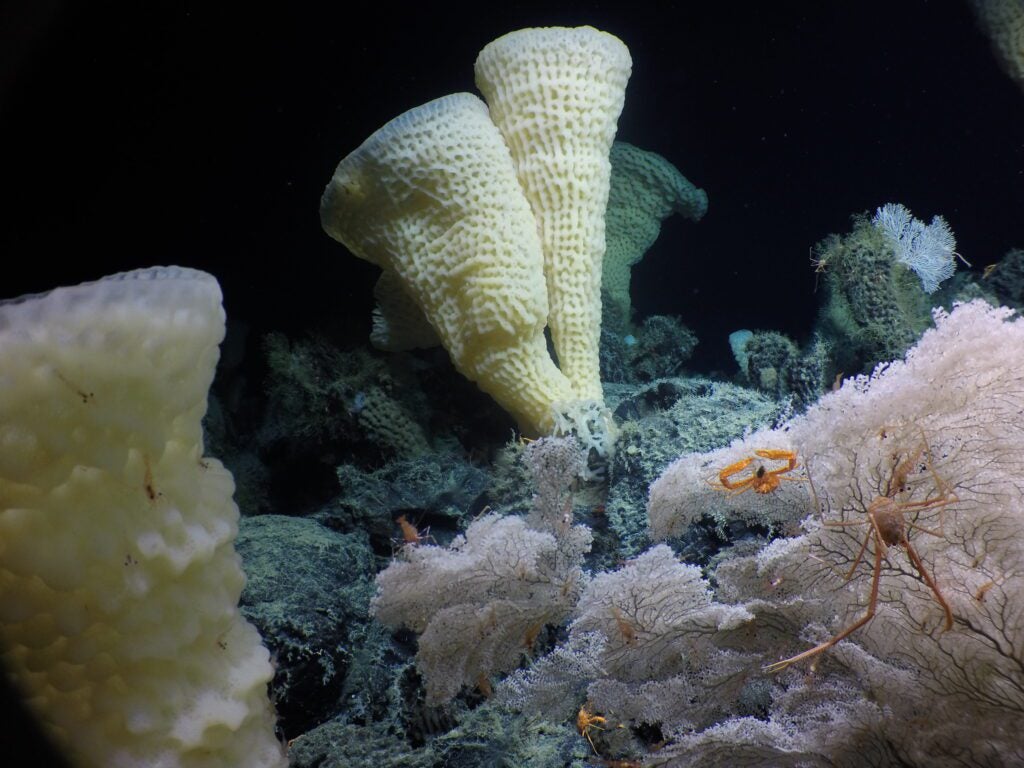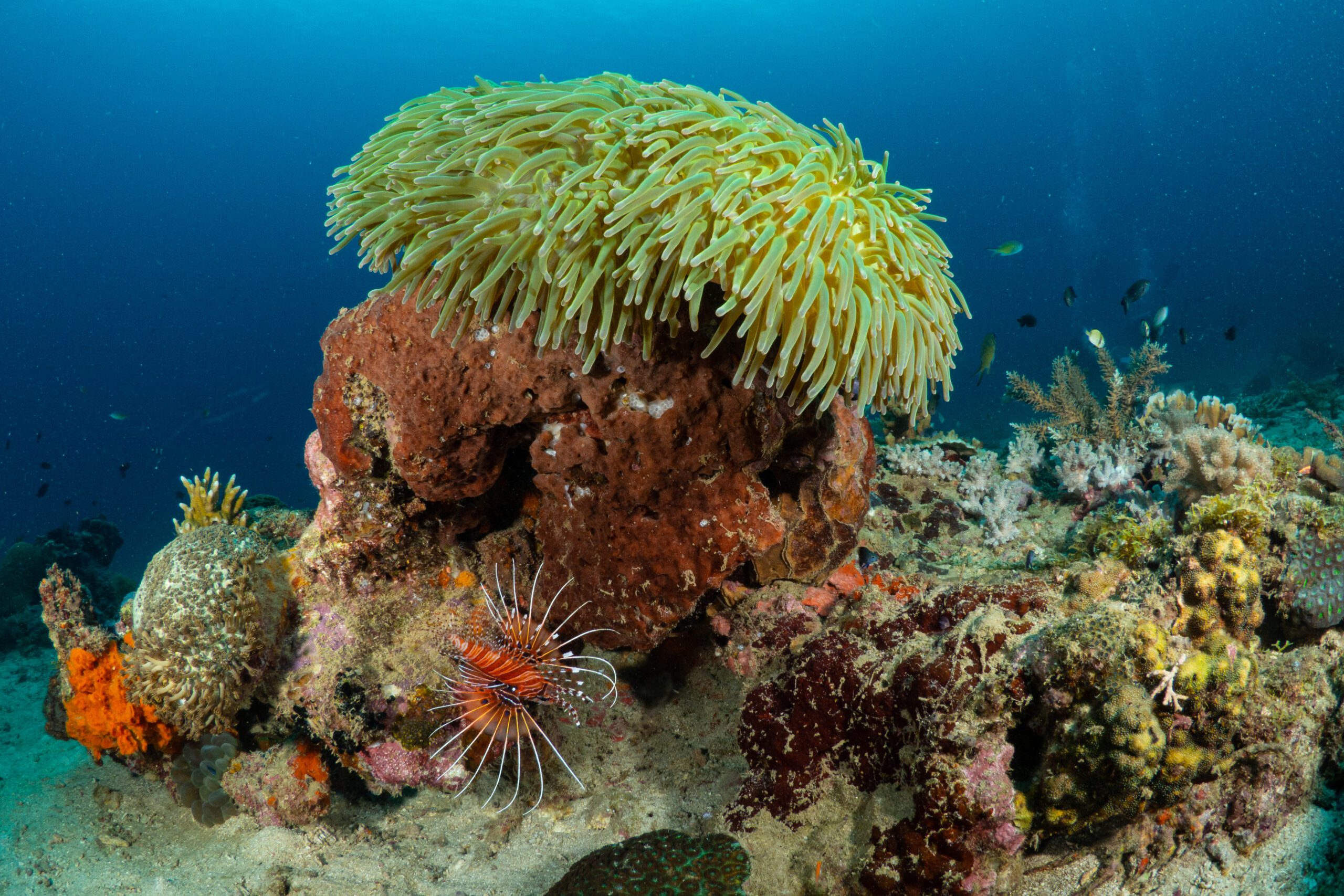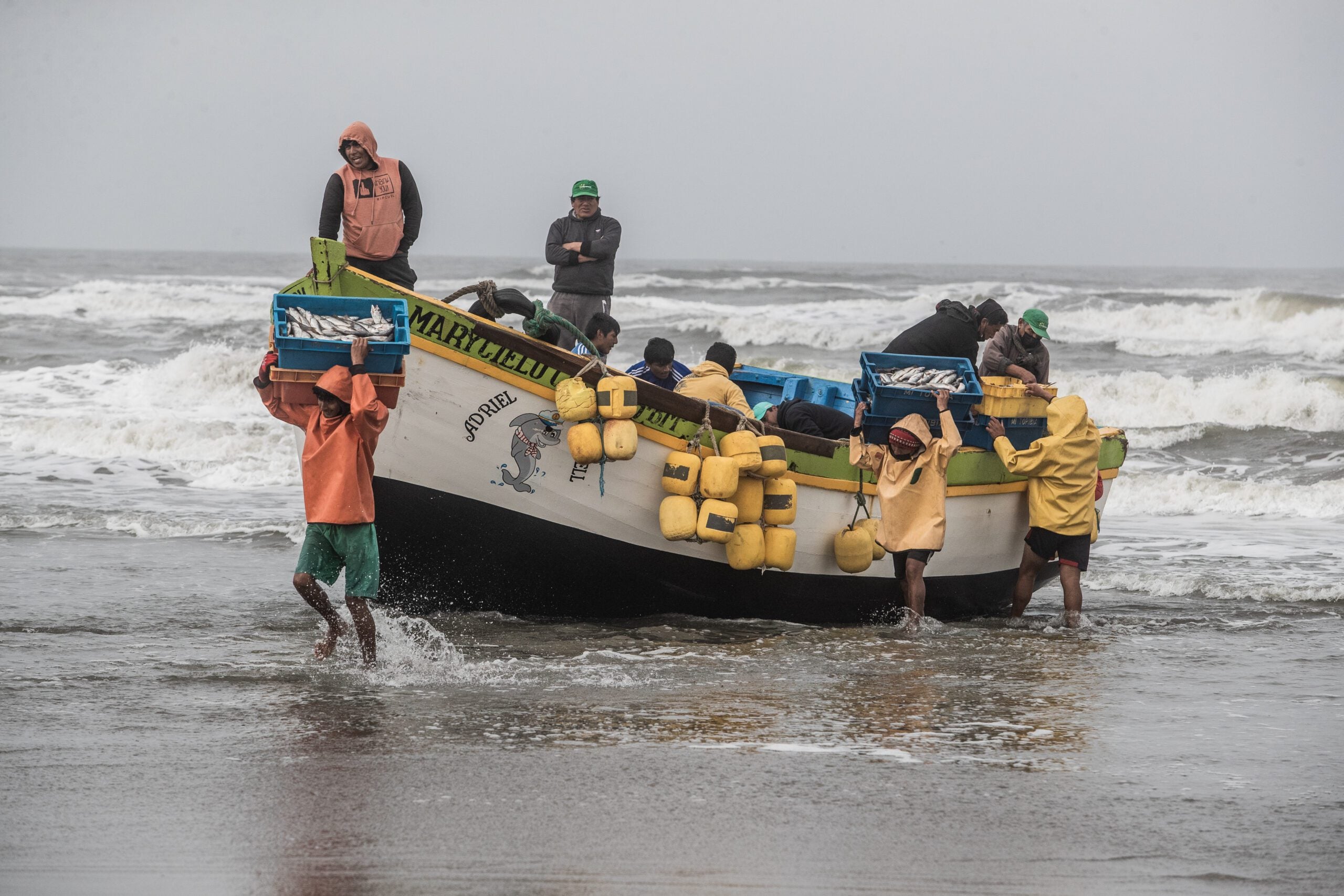May 10, 2023
To 30×30 and Beyond
BY: Emily Nuñez
Countries around the world are working to protect 30% of their land and sea by 2030. Oceana is contributing to this goal and working with allies to protect even more marine habitat.
Off the western coast of Canada in the Northeast Pacific, an underwater mountain range looms large. These submerged peaks — once active volcanoes — are now hotbeds of marine activity.
Strong currents flank these seamounts, delivering a steady flow of food to local fauna. Ancient sponges and corals cling to cliffs, nourished by the nutrient-rich waters that well up from the ocean’s depths. Migrating humpback whales and orcas drop in to get their fill. And an array of other animals, from octopuses to crabs to rockfish, all have a part to play in this intricate underwater web.
Despite the importance of these waters to marine life and local communities, less than 6% of the Northeast Pacific Seamounts are protected. Oceana, along with the Canadian federal government, academic partners, and First Nations partners, explored the area in a 2018 expedition. Oceana has supported the call to establish a marine protected area (MPA), co-managed by First Nations, that safeguards over 133,00 square kilometers (over 51,000 square miles) of ocean from all industrial activities, including the kinds of bottom-contact fishing gear that destroy healthy habitats.
This MPA would cover more than 2% of Canada’s marine territory, moving the nation closer to preserving 30% of its ocean—a commitment made by Canada’s federal government as part of the history-making global 30×30 initiative to protect 30% of the planet’s land and sea by 2030. Only 8% of the world’s oceans are currently protected, but calls for more sweeping conservation measures are growing louder.
During the 15th Conference of the Parties to the UN Convention on Biological Diversity (COP15) in Canada last December 2022, nearly 200 countries approved an ambitious agreement that includes the 30×30 target, better methods of measuring progress, and an acknowledgement of the importance of working closely with Indigenous peoples and other local communities whose history and connections to the land and sea must be respected.
Oceana and its allies have successfully campaigned to create MPAs in critically important waters around the world. Oceana also pairs these protections with other policy changes that improve the overall health of the ocean.
“If you have a tightly protected area surrounded by an extremely degraded ocean, it won’t stay healthy for long because the ocean is so interconnected,” explains Joshua Laughren, Senior Vice President for Oceana in Canada. “Meeting 30×30 will be a tremendous achievement, but there are other habitat actions and protections that are necessary to ensure that the areas we protect through 30×30 are – and remain – healthy.”
Oceana’s “all-of-the-above” approach to 30×30 includes not only creating new MPAs, but also strengthening the management of existing ones, working with local communities and Indigenous Peoples to protect coastal waters, and limiting destructive activities such as bottom trawling and oil and gas drilling.


Biodiversity boosters
To date, Oceana and its allies have protected more than 10 million square kilometers (nearly 4 million square miles) of ocean habitat around the world. This includes both MPAs and bans against bottom trawling, a form of fishing that drags a heavy net across the seafloor, bulldozing everything in its path.
Delegates at COP15 enshrined the 30×30 goal in the international agreement, but did not specify how that target should be reached. Tools include strict “no-take” zones where all fishing is prohibited, areas co-managed with communities or Indigenous Peoples, and multi-use areas. The intention is for these areas to provide long-term and enforceable protection and conserve biodiversity.
When created in the right places and under the right management conditions, MPAs and other marine reserves have been proven to preserve biodiversity, help overfished species recover, and make habitats more resilient to climate change. These protections also yield numerous human benefits. For example, a study in Nature found that strategic ocean protection could improve the health of fish populations, resulting in an increase in the global fish catch by 8 million metric tons.
“When we leave areas protected so fish can reproduce, it means more fish in surrounding waters, too, where local fishers are free to catch them” – Dr. Kathryn Matthews
“When we leave areas protected so fish can reproduce, it means more fish in surrounding waters, too, where local fishers are free to catch them,” says Dr. Kathryn Matthews, Chief Scientist at Oceana.
This is crucial to countries like the Philippines, where more than 100 million people are nutritionally-dependent on fish. Oceana is campaigning to create a protected seascape, connecting MPAs in the coral-rich waters surrounding Panaon Island, a small island in the Philippines. Healthy coral reefs are bustling with biodiversity, and in many parts of the world they play an outsized role in a community’s food security and nutrition.
Oceana surveyed 188 fishing households on Panaon Island and found that over one-third of respondents rely on nearly all of their catch to feed their families. In addition, 79% of households believe that marine sanctuaries have a positive impact on their livelihoods.
Places like Panaon Island can only offer a range of benefits if they are properly protected. In Europe, Oceana is campaigning to strengthen the management of “paper parks” that are protected on paper, but not in practice. Oceana found that destructive fishing methods like bottom trawling were occurring in 86% of “protected” areas that were specifically created to safeguard seabeds.
In fact, the average intensity of bottom trawling in MPAs across the European Union was 1.4 times higher than in non-protected areas, according to a 2018 study co-authored by Dr. Boris Worm, an Oceana Science Advisor and professor at Dalhousie University in Halifax, Canada.
“Achieving some form of legal protection for 30% of the ocean’s area is critical – and ensuring that those protected areas receive proper management and enforcement is, too,” says Matthews.

Oceana is campaigning to protect Panaon Island, a rich coral reef in the Philippines that, if protected, would benefit marine life and the people there who depend on the ocean. © Oceana/Danny Ocampo
Coasts with the most
In addition to establishing and improving MPAs, Oceana also focuses on protecting coastal waters for the benefit of local communities and small-scale fishers.
Peru has some of the most productive seas in the world, including the world’s biggest fishery for anchovies. The majority of this enormous offshore fishery is exported and used as “fishmeal” to feed livestock or in the aquaculture industry. On the other hand, coastal waters are especially important to artisanal fishers and local communities.
On paper, artisanal fishers are given exclusive fishing rights up to five nautical miles from the coast, where they can catch coastal fish and invertebrates without worrying about interference and unfair competition from industrial trawlers (though industrial trawlers do not always respect it). The coastal zone provides livelihoods and income for coastal communities who often have few other options.
Some small-scale fishing methods are better for the oceans than others, however. Some local fishers are using long fishing nets called purse seines to ensnare anchovies. Because these nets are designed for deeper waters, they can drag along the seafloor and cause damage in much the same way a bottom trawl would.
These nets are responsible for higher rates of bycatch and can also snag the lines of other artisanal fishers who use hooks to catch fish. In extreme cases, they can even pose a safety risk to divers searching for shellfish and octopus.
“Sometimes divers see these long nets and feel threatened because they could become trapped in them,” says Juan Carlos Riveros, Oceana’s Science Director in Peru. “At the very least, long purse seine nets can displace their equipment and close off certain areas to fishers.”
Oceana is campaigning to ban this type of fishing gear up to three miles from Peru’s coast and ensure these regulations are enforced by using satellites to monitor the location of vessels.
“One fisher told me, ‘Ten years ago, I would not take this small fish with me. I would release it. But now I have to take it because it’s the only fish that I have to feed my people.’ And that’s a problem.” -Juan Carlos Riveros
Riveros said artisanal fishers tend to take the least from the ocean, but suffer the most from the consequences of overfishing, bycatch, and habitat destruction. Fishers in Peru have had no choice but to bring smaller and smaller fish to market over the years — a biological consequence of placing too much fishing pressure on populations of larger fish.
“In most cases, fishers are fully aware of the problems they have, but in some ways they are trapped in their situation,” Riveros reflects. “One fisher told me, ‘Ten years ago, I would not take this small fish with me. I would release it. But now I have to take it because it’s the only fish that I have to feed my people.’ And that’s a problem.”
Oceana’s team in Peru is campaigning for new, national fisheries legislation that would better protect the artisanal zone by banning damaging fishing gear, increasing surveillance of illegal fishing, and enforcing regulations that keep fish stocks healthy.
Meanwhile, in the Philippines, Oceana is also campaigning for healthier coasts and mangrove habitats. These hardy trees act as nurseries for baby fish, sequester large amounts of carbon in their roots, and even form a natural buffer that protects coastal residents from typhoons, which have increased in frequency and severity due to climate change. However, aquaculture companies and developers have already wiped out more than half of the country’s mangroves, leaving marine life and communities vulnerable. Now Oceana is campaigning to conserve and restore mangroves before they are lost to industry.
Coastal protections like these achieve many of the same goals as “formal” MPAs: stopping activities that jeopardize the health of the oceans and livelihoods of local populations.

Artisanal fishers on Santa Rosa Beach, Peru, unload their catch. Oceana is campaigning to better protect the five nautical miles from the coast that is reserved exclusively for artisanal fishers. © Oceana/Sebastián Castañeda
Local partners, proven results
Oceana’s approach — partnering with local communities and using a combination of science, law, policy, grassroots organizing, and communications to protect locally important waters — is designed to halt destructive activities in their tracks.
Artisanal fishers in Chile teamed up with Oceana to create the Juan Fernández Archipelago Marine Park — the largest marine park in the Americas — which protected the area from threats such as bottom trawling while allowing lobster fishers to continue their centuries-old sustainable fishing practices. They have also been central to Oceana’s successful campaign to protect the waters off of Pisagua Bay, where the abundance of phytoplankton, krill, and prawn are a major draw for commercially valued fish and other species.
Around the world, other communities are also organizing. Belizeans banded together to stop bottom trawling and offshore drilling — which threatens the health of ocean ecosystems and exacerbates the climate crisis — in all of their country’s waters. Filipinos achieved similar protections against bottom trawling in their municipal waters. In Brazil, artisanal fishers flooded their state representatives with WhatsApp messages and successfully convinced them to vote for a bottom trawling ban in the southernmost state of Rio Grande do Sul. Coastal communities across the U.S. have rallied against the expansion of offshore drilling.
All of these habitat campaigns support the global 30×30 goal — either directly or indirectly — by winning habitat protections, coast by coast and country by country. For 30×30 to truly be global in scope and successful in the long-term, local communities must continue to be part of the process, Laughren emphasizes.
“We want to make sure that the protections we’re creating are for the benefit of local people and Indigenous communities so that they can continue to benefit from the ocean’s resources in a sustainable way,” Laughren says. “Only then can we claim that 30% of the ocean is protected.”



